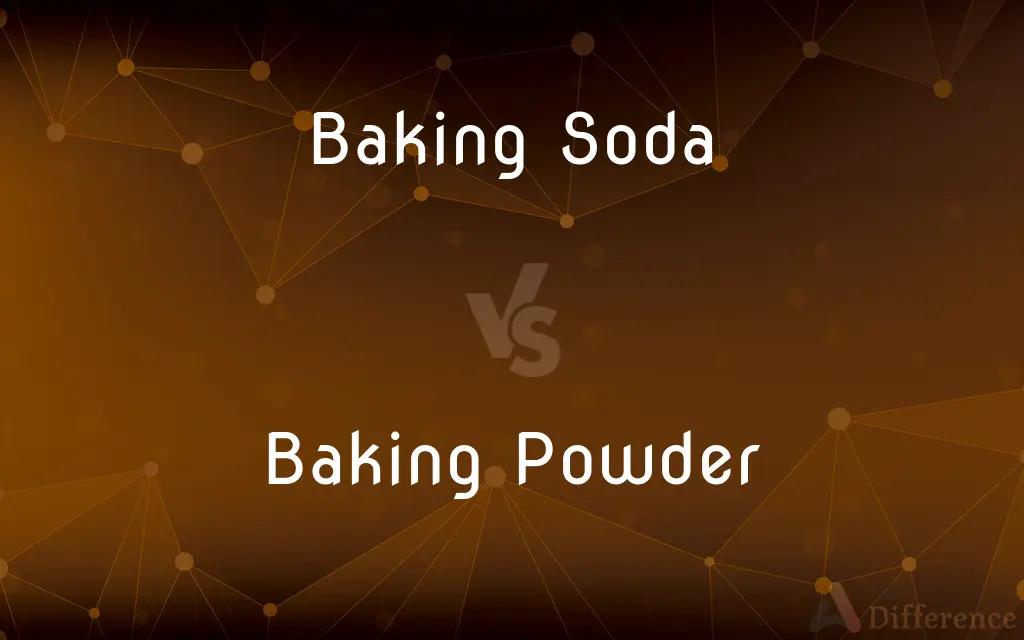Baking Soda vs. Baking Powder — What's the Difference?
By Maham Liaqat & Urooj Arif — Published on December 20, 2024
Baking soda is a base requiring an acid to activate, while baking powder contains baking soda and an acid, activating with moisture.

Difference Between Baking Soda and Baking Powder
Table of Contents
ADVERTISEMENT
Key Differences
Baking soda, or sodium bicarbonate, is a pure leavening agent that requires the presence of an acidic ingredient (like yogurt, lemon juice, or buttermilk) to produce carbon dioxide gas, which causes dough or batter to rise. It's known for its versatility beyond baking, including uses in cleaning and deodorizing. Baking powder, on the other hand, is a complete leavening agent that combines baking soda with a dry acid (such as cream of tartar) and often a starch to prevent clumping. It can come in two forms: single-acting, which reacts with moisture, and double-acting, which reacts in two phases, once when moistened and again when heated.
The ratio of use differs significantly between the two. Baking soda is much stronger than baking powder, so recipes typically require less of it. For instance, a teaspoon of baking powder can be substituted with a quarter teaspoon of baking soda plus half a teaspoon of an acid.
In terms of flavor, baking soda can leave a metallic taste if not neutralized by an acid, whereas baking powder is formulated to avoid such issues, making it a safer choice for recipes where the balance of acidic ingredients might be more delicate.
Choosing between baking soda and baking powder depends on the recipe's ingredients. If a recipe includes natural acids, baking soda can be used to take advantage of these components. In contrast, baking powder is preferred for recipes without acidic elements, ensuring the leavening process occurs without additional ingredients.
Texture and rise are also affected by the choice between baking soda and baking powder. Baking soda can create a more pronounced rise in doughs and batters that contain an acid, while baking powder provides a consistent rise throughout the baking process due to its double-acting properties.
ADVERTISEMENT
Comparison Chart
Composition
Pure sodium bicarbonate
Sodium bicarbonate, acid (usually cream of tartar), and starch
Activation
Requires an acid
Activated by moisture (and heat if double-acting)
Usage Ratio
Stronger, used in smaller amounts
Used in larger amounts compared to baking soda
Taste
Can leave a metallic taste if not balanced
Formulated to avoid metallic taste
Leavening Type
Single-acting
Single-acting or double-acting
Ideal For
Recipes with acidic ingredients
Recipes without natural acids
Compare with Definitions
Baking Soda
A base that needs an acid to activate.
Adding baking soda to buttermilk pancakes makes them fluffy.
Baking Powder
Available in single or double-acting forms.
Double-acting baking powder helps cakes rise twice.
Baking Soda
Stronger, requiring careful measurement.
A little baking soda goes a long way in recipes.
Baking Powder
Ensures consistent leavening.
Baking powder gives a uniform rise to muffins and cakes.
Baking Soda
Can affect flavor if unbalanced.
Too much baking soda without enough acid can taste metallic.
Baking Powder
Convenient, requiring no additional acids.
Baking powder works well in recipes like biscuits.
Baking Soda
Provides quick rise when activated.
Baking soda creates immediate bubbles in batter.
Baking Powder
Neutral taste in baked goods.
Baking powder ensures a balanced flavor without aftertastes.
Baking Soda
Used beyond baking for cleaning.
Baking soda can remove stains from countertops.
Baking Powder
Contains baking soda and an acid.
Baking powder is self-contained for easy rising.
Common Curiosities
How do I substitute baking powder for baking soda?
Generally, you can substitute 1 teaspoon of baking powder with a mixture of 1/4 teaspoon baking soda and 1/2 teaspoon acid.
Can baking powder and baking soda be used interchangeably?
Not directly, due to differences in composition and how they activate. Substitutions must account for the presence of acid in the recipe.
What happens if I use too much baking soda?
Excess baking soda can lead to a metallic taste and overly porous or greenish hue in baked goods.
How can I test if baking powder or soda is still active?
For baking soda, add vinegar and look for fizzing. For baking powder, mix with hot water and expect bubbling.
Why do some recipes call for both baking soda and baking powder?
Some recipes require the strong leavening power of baking soda for the acids present, plus baking powder to ensure a sufficient rise.
Is there a health difference between the two?
Both are considered safe for consumption in cooking and baking quantities, though baking soda has more non-culinary uses.
How does altitude affect the use of baking soda and powder?
Higher altitudes can affect leavening, often requiring adjustments to baking soda and powder quantities to prevent over-rise.
Why does baking powder have starch?
Starch prevents moisture absorption, ensuring the baking powder doesn't react prematurely.
What role does the acid in baking powder play?
The acid in baking powder reacts with sodium bicarbonate, releasing carbon dioxide for leavening without external acids.
Does baking powder expire?
Yes, baking powder loses its potency over time. It should be replaced every 6 to 12 months for best results.
What is the environmental impact of using baking soda and powder?
Both have minimal direct environmental impacts when used in typical household quantities for baking.
How should baking soda and powder be stored?
In a cool, dry place in airtight containers to maintain their potency over time.
Can baking soda improve health?
Baking soda has various health-related uses, like as an antacid, though its effectiveness and safety depend on the context.
Can I make my own baking powder?
Yes, by mixing two parts cream of tartar with one part baking soda and one part cornstarch.
What are the natural acids that react with baking soda?
Common acids include lemon juice, vinegar, buttermilk, and yogurt, which can activate baking soda.
Share Your Discovery

Previous Comparison
Purchase Order vs. Invoice
Next Comparison
Split System vs. Reverse CycleAuthor Spotlight
Written by
Maham LiaqatCo-written by
Urooj ArifUrooj is a skilled content writer at Ask Difference, known for her exceptional ability to simplify complex topics into engaging and informative content. With a passion for research and a flair for clear, concise writing, she consistently delivers articles that resonate with our diverse audience.












































